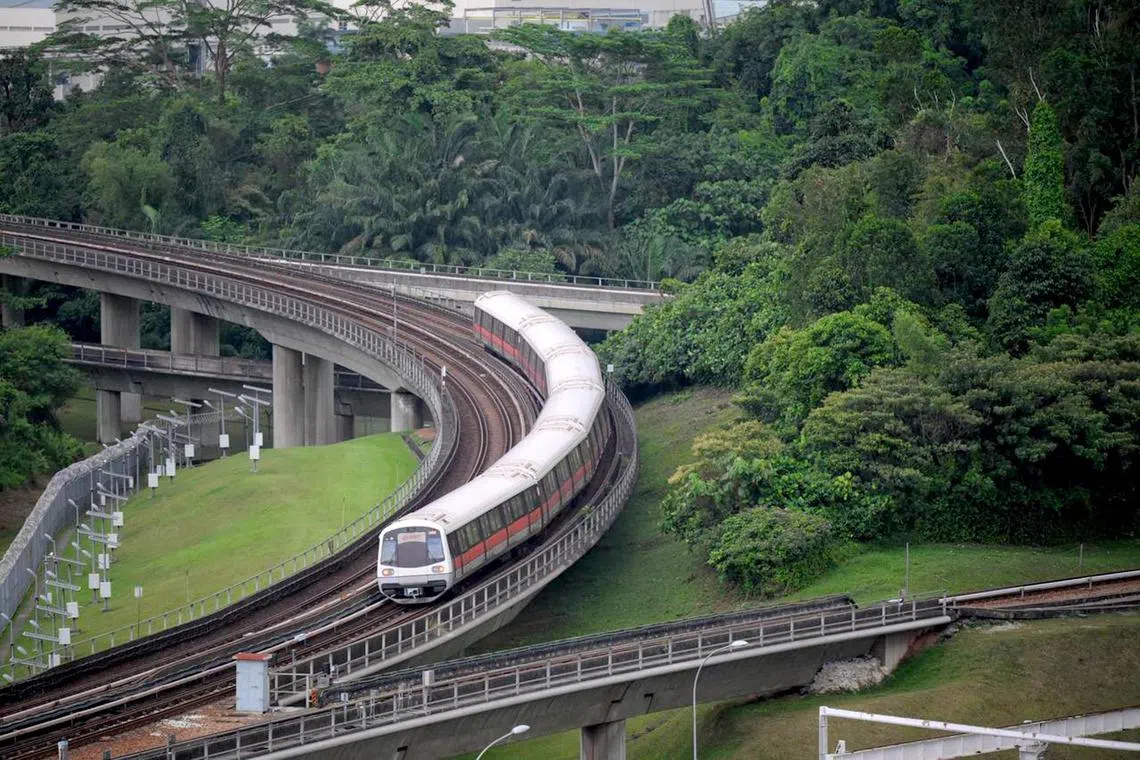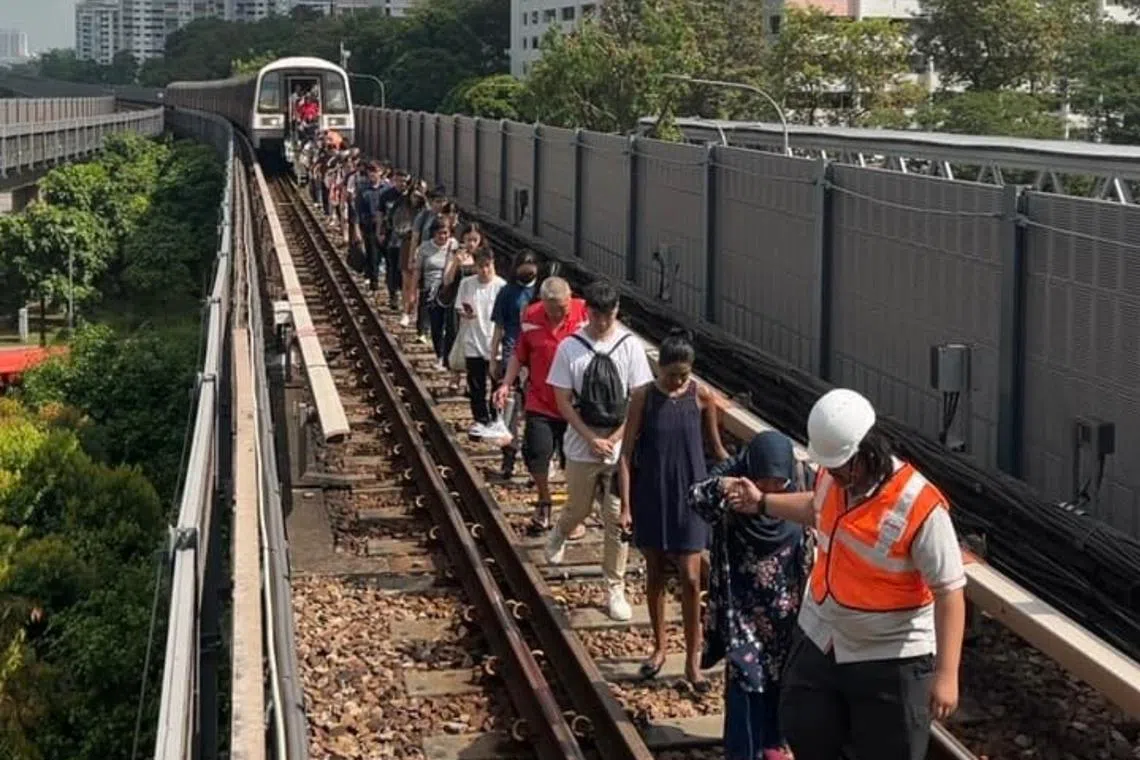News analysis
Rail operators have to maintain high reliability standards to preserve commuters’ confidence
Sign up now: Get ST's newsletters delivered to your inbox

A train used for testing travelling between Clementi and Jurong East MRT stations on Sept 30.
ST PHOTO: MARK CHEONG
Follow topic:
SINGAPORE – Even before the ongoing investigations into the major disruption on the East-West Line (EWL)
In Parliament this week, some 21 MPs posed questions on two main topics: Is the current maintenance regime of the MRT network sufficient, and are the operators committing enough resources to ensure that it remains reliable?
It could be that the breakdown on the EWL was a one-off episode – albeit a very disruptive one – rather than something stemming from a fundamental issue in the way rail maintenance is handled.
Still, the concern is understandable, given the massive impact of the incident.
On each of the six days that service stopped on the EWL, 500,000 out of 2.8 million MRT journeys were affected.
Among those affected were children taking the Primary School Leaving Examination and N-level examinations. Daily commuters who relied on the train had to make different arrangements that were less than ideal in terms of time, expense and effort.
Mr Gan Thiam Poh (Ang Mo Kio GRC) and Workers’ Party (WP) MP Dennis Tan (Hougang) were among the MPs who wanted to know if the existing maintenance regime needed a relook. Others, like Mr Saktiandi Supaat (Bishan-Toa Payoh GRC), questioned if the operators had taken their foot off the pedal on maintenance efforts.
Transport Minister Chee Hong Tat responded that as part of the ongoing investigation, the existing processes for maintenance are also being checked. This is on top of the regular review of such protocols that is conducted with operators SMRT and SBS Transit.
He also said that the two rail operators have not cut back on their maintenance efforts.
“When we look at the amount that they are spending, they have both continued to focus on maintenance and building up the engineering and technical expertise, which is equally important, the talent pool. That is something which will remain a priority for LTA (Land Transport Authority) and the operators,” said Mr Chee.
In the current set-up, the operators are responsible for the maintenance of the rail infrastructure, and operating assets like the trains and signalling systems. The LTA, as the owner, plans the building up, replacements and upgrading of these assets.
Mr Chee also noted that the MRT network is much more robust today than it was in the past.
Slightly over a decade ago, breakdowns and disruptions were more frequent.
In 2012, trains travelled an average of 67,000km before experiencing a service delay of at least five minutes.
This is known as mean kilometres between failure (MKBF), a widely accepted engineering measure for rail reliability.
The investments in repairs and refurbishments of the MRT network at the time pushed the MKBF up to 94,000 train-km in 2013. By 2018, the rail system’s MKBF was 690,000 train-km.
Following the efforts to intensify maintenance and renew the systems and trains, the MRT network has, since 2019, consistently achieved at least 1 million train-km in MKBF.
The 1 million train-km is considered a high benchmark for rail reliability. It was first set as a 2020 target by former transport minister Khaw Boon Wan in 2017. In the first half of that year, the network’s MKBF was 393,000 train-km.
A decade-long upgrade costing $2.6 billion to renew six core systems on the North-South Line and the EWL – the oldest and most heavily used rail lines on the network – was completed in late 2023.
The renewal included new trains, which are still being progressively delivered to replace the older ones that are in service. The last of the earlier generation trains on the EWL is expected to be replaced by end-2026.
Based on the estimates for the 12 months ending September 2024, five MRT lines – East-West, North-South, Circle, North East and Downtown – surpassed the 1 million train-km target.
The Thomson-East Coast Line, which is not fully opened, was not measured.
Giving the estimated MKBF figures in Parliament on Oct 15, Mr Chee said that the lines’ performance was comparable with the most reliable overseas metros.
Still, a question can be asked if reliability had dropped off in the recent past before the EWL disruption.
According to LTA’s report, the estimated MKBF figures for the 12 months ending September for four MRT lines except the Circle Line were below the MKBF figure for the 12 months’ rolling average ending March 2024.
That notwithstanding, at more than 1 million train-km before faults, Singapore’s MRT network is faring well.
In his response to WP’s Louis Chua (Sengkang GRC), Mr Chee said each line has its own characteristics, including its age, systems used and the operating environment, which could be underground or overground.
Put another way, there is no universal method to tackle the challenges of keeping all the MRT lines working. Instead, it is important to look at the lines individually to understand why they performed the way they did and identify any areas for improvement.
Based on LTA’s rail service reliability report, the EWL’s MKBF has improved from 3.36 million train-km in 2023 to 5.05 million train-km in the 12-month rolling average ending in March 2024. As might be expected, the estimated MKBF for the 12 months until September 2024 took a hit with the massive disruption and ended at 2.03 million train-km.
The report also captured the number of service delays that lasted for more than 30 minutes from 2020 to the first quarter of 2024. Between 2020 and 2023, three to seven of these delays were recorded each year on the overall MRT network. One was reported in the first quarter of 2024. The EWL disruption in September was another such incident.
On paper and in practice, the disruption in September – massive and consequential though it was – may not necessarily point to a deeper problem at fault.

About 850 commuters on board a stalled train near Clementi MRT station safely disembarking on the tracks and being guided back to the station platform on Sept 25.
PHOTO: SMRT/FACEBOOK
Nonetheless, a recent spate of service disruptions before and after that severe incident has not instilled renewed confidence in the MRT network.
The Circle Line, for example, saw two consecutive days of disruptions on Sept 17 and Sept 18 for different reasons, a week before the major incident on the EWL.
On Oct 1, the day the EWL resumed service, the Thomson-East Coast Line reported a fault
For commuters who do not have the time or patience to understand how the MKBF measure works or to parse the individual circumstances of each disruption, a series of faults can add up to a disquieting picture regarding train reliability.
The rail network plays a role in the public transport system that cannot be replaced easily with buses.
Mr Chee noted that even with up to 80 double-decker bridging buses deployed each day during the period of the disruption, these were unable to match the full capacity of the EWL.
For context, a six-car train on the EWL can carry more than 1,000 passengers and run at two- to three-minute intervals, travelling at up to 80kmh. A double-decker bus can carry up to 120 passengers and runs at much lower speeds.
Mr Chee, in response to a question about how the MRT disruption will impact the Government’s efforts to promote a car-lite society and encourage reliance on rail transport, said the commitment to provide a safe, reliable and resilient MRT system remains unchanged.
The MRT network is still expanding. The developments include the extension of the Circle Line, due in 2026, the opening of the Jurong Region Line from 2027 to 2029, and the Cross Island Line entering service in the early 2030s. This will add 100km of rail to the network.
The MRT system has come a long way in terms of coverage, connectivity, speed of travel and, yes, reliability. But it may not take all that much for it to unravel in the minds and experience of those who rely on it every day. Maintenance and vigilance cannot be allowed to falter.


